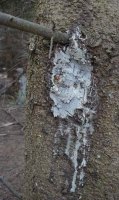
 |
 Spruce
gum is used to seal the seams in a birchbark canoe and make it watertight. Spruce
gum is the sap of the spruce tree. You can find it on the same trees that you
get roots from. Where there is a wound in the tree the sap oozes out and dries
to form a hard mass. I found many patches of oozing gum on the trees I looked
at and in the middle of many of them was a grub which seemed to be burrowing
into the tree. Click on the picture to see it bigger.
Spruce
gum is used to seal the seams in a birchbark canoe and make it watertight. Spruce
gum is the sap of the spruce tree. You can find it on the same trees that you
get roots from. Where there is a wound in the tree the sap oozes out and dries
to form a hard mass. I found many patches of oozing gum on the trees I looked
at and in the middle of many of them was a grub which seemed to be burrowing
into the tree. Click on the picture to see it bigger.
To collect the gum, scrape it off with a stick or old knife into a bucket or plastic bag. The gum has to be purified and mixed with a bit of fat (such as lard) before it is used. First melt it in an old pot until it is liquid. Then strain it through a cloth, squeezing it tight to get all the good gum out and leave the sticks, dirt and grubs(!) behind.
Mixing the right amount of fat into your gum is a magic art as far as I can see. If there is not enough fat, the gum will harden and crack like hard candy. If there is too much fat, it will not harden and will run out of the canoe's seams. This all depends on the temperature at which the canoe will be used. In warm weather, you need gum with less fat so it will stay hard. In cold weather you need more fat so the gum will not crack. The native people used to use different gum mixtures for different times of the year.
Some people use roofing tar instead of gum to seal their canoes. It works well and does not have to be reapplied periodically like gum. I used spruce gum because it was free and easy to find.
Applying spruce gum is fun. You heat up the gum and fat mixture until it is liquid but not too runny. You spoon up some on a stick and spread it on the canoe. Then you squish it into the seams with your finger which must be wet so it doesn't stick (just lick your finger every once in a while). The gum will feel like soft chewing gum.
Back to the Materials page
© Judy Kavanagh 2001